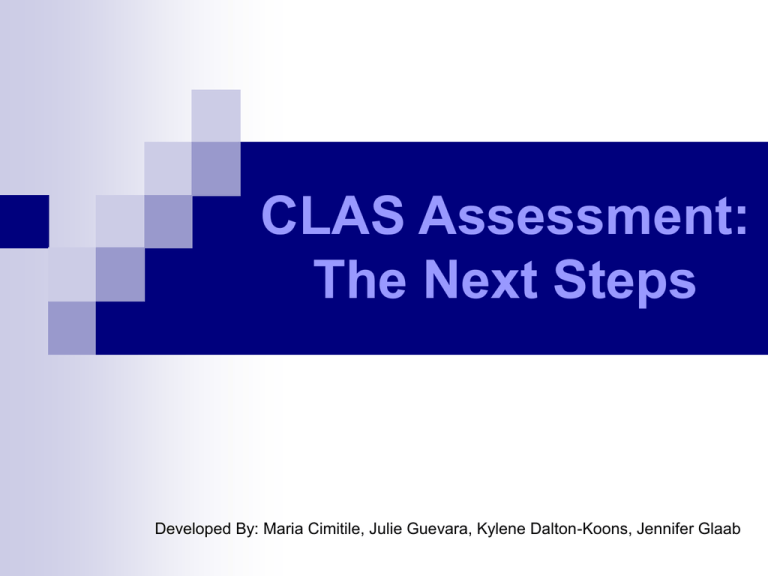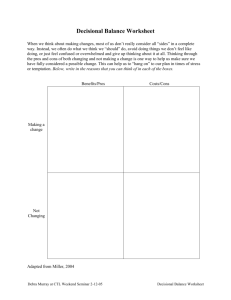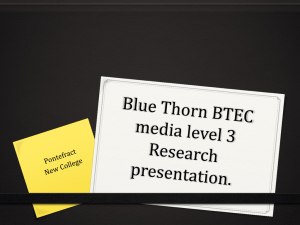CLAS Assessment: The Next Steps
advertisement

CLAS Assessment: The Next Steps Developed By: Maria Cimitile, Julie Guevara, Kylene Dalton-Koons, Jennifer Glaab Strategic & Assessment Planning Assessment Plan Goal Strategic Plan Goal #1 Goal #2 Goal #3 Goal #4 Goal #5 Goal #6 Goal #7 Goal #8 #2 Goal #5 Goal #8 Assessment Cycle at GVSU Data Collectio n (2) Guides Analyzed in (Continuous ) Training on Measures (Rubrics, Surveys, Exams, Other) Str at eg ic Pl an Modifies (1) Assessmen t Plan Modifies GVSU Program Study (4) •Assessment reports due to UAC every three years •Assessment plan revisions due to UAC every three years included with assessment report submitted to UAC •GVSU program study due every six years (cycle incorporates 1, 2, & 3) (3) UAC Assessment Report Incorporated in Assessment Strategies Rubric – A rubric is simply a scoring guide, and can be useful in standardizing assessment. Rubrics provide less biased measures. PROS: expectations explicit, convincing documentation, accurate, unbiased, consistent, emphasis on “doing” over understanding, make criteria explicit, make scoring easier and faster, make scoring more accurate, less bias and consistent, reduce arguments with students CONS: can lack credibility; does not provide qualitative, thorough feedback; inconsistencies between evaluators, does not allow for variability in scoring, difficult to use with independent projects Assessment Strategies Alumni and employer surveys – The use of alumni and employer surveys in assessment allows an external glimpse of the strengths and weaknesses of a program. Feedback from these sources reveals achievement of learning goals, as well as student readiness for the work force (Suskie, 2004; Palomba & Banta, 1999). This assessment strategy is accomplished through mail and/or telephone surveys, focus groups, and interviews. PROS: qualitative and quantitative, gives external perspective, vast array of possible questions, leading to many kinds of analysis CONS: feedback rate, difficult to code, may have skewed reactions (validity), not scientifically constructed, cannot be generalized, vary depending on economy Assessment Strategies Exams - a common way to demonstrate student knowledge. If professors use the same exam for multiple years, it can provide longitudinal data on students’ learning. PROS: direct measure of skill/knowledge, assess a large number of people in short amount of time, easier to score CONS: time invested in original development, difficult to write items which test higher-order thinking, “Teaching to the test” Assessment Strategies Embedded testing – Assessment that is incorporated into assignments can present valuable information and data regarding student learning, as well as achievement of program goals (Suskie, 2004). Because these measures are “embedded” in the curriculum, no additional labor is required. PROS: representative, standardized, serve dual purpose (less work, use of existing resources) CONS: inconsistent among evaluators, reliability Assessment Strategies National standardized tests – The use of national standardized tests is important in education evaluation. This comprehensive assessment strategy quantifies outcomes and allows performance comparison on a local, state, and national level. PROS: centralized, consistent, comparative, may be generalized, quantitative, objective, reliable, valid, provide norms, reliability/validity already proven, readily available CONS: not qualitative, no room for subjectivity, unintended consequence of narrowing curriculum, inconsistent with active learning, costs Assessment Strategies Pre-test/post-test student assessment – This assessment strategy can evaluate learning, as well as achievement of learning goals, through use of a benchmark measure. These tests are administered by faculty on the first and last day of class. PROS: controls internal validity (produced by intervention), quantitative, shows learning CONS: imprecise, difficult to interpret results/answers Assessment Strategies Portfolios of student work evaluation – Student portfolios may be used to record and assess student learning (Suskie, 2004). This strategy demonstrates improvement among the learner. PROS: centralized (one place of evidence), integrates instruction and assessment CONS: not standardized, subjective, time consuming Assessment Strategies External reviews by peers – Peer evaluation can influence student participation, as well as enhance interpersonal skills (Suskie, 2004). PROS: CONS: qualitative (provides experiential data) subjective, not quantitative, inaccurate, rating bias and errors







